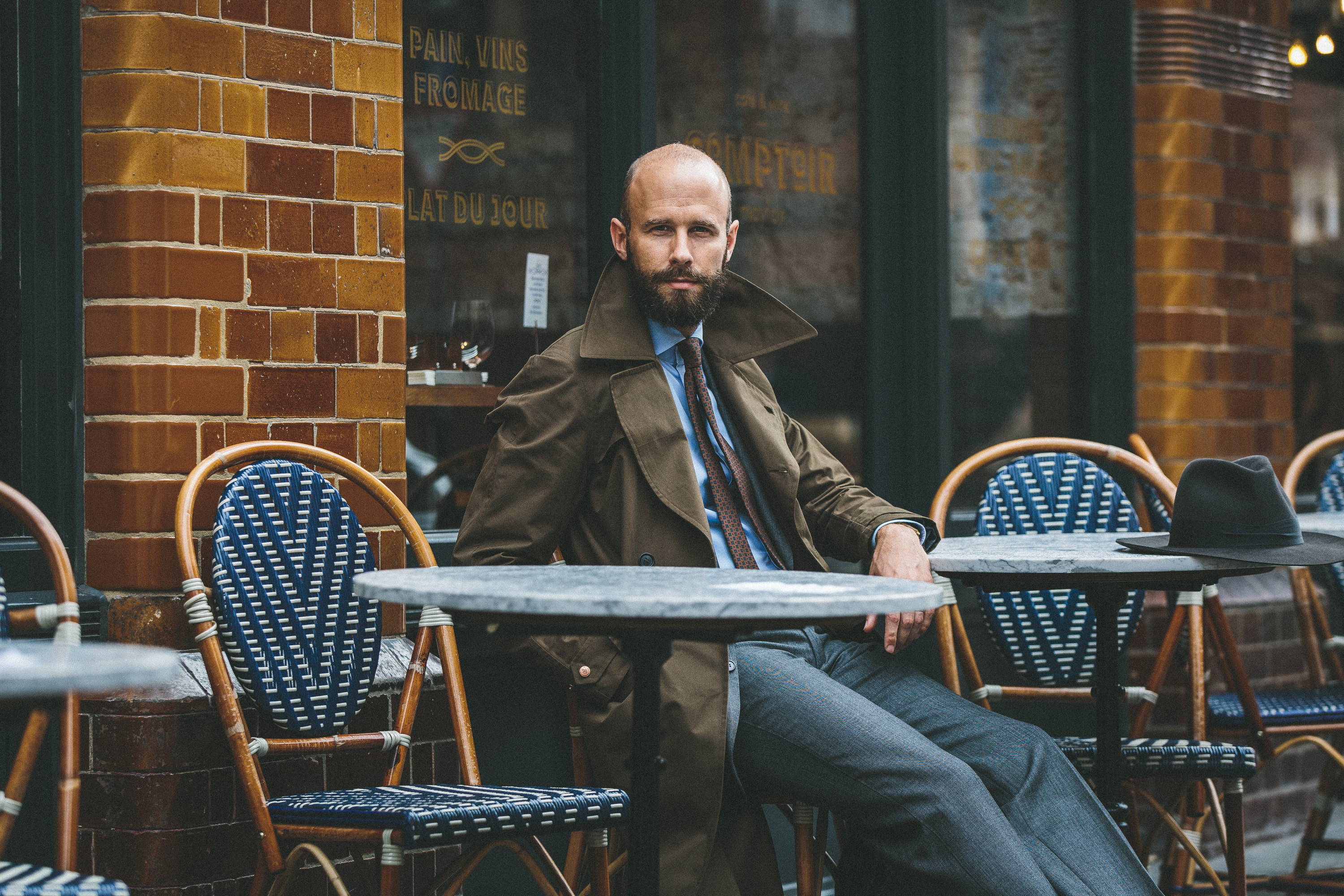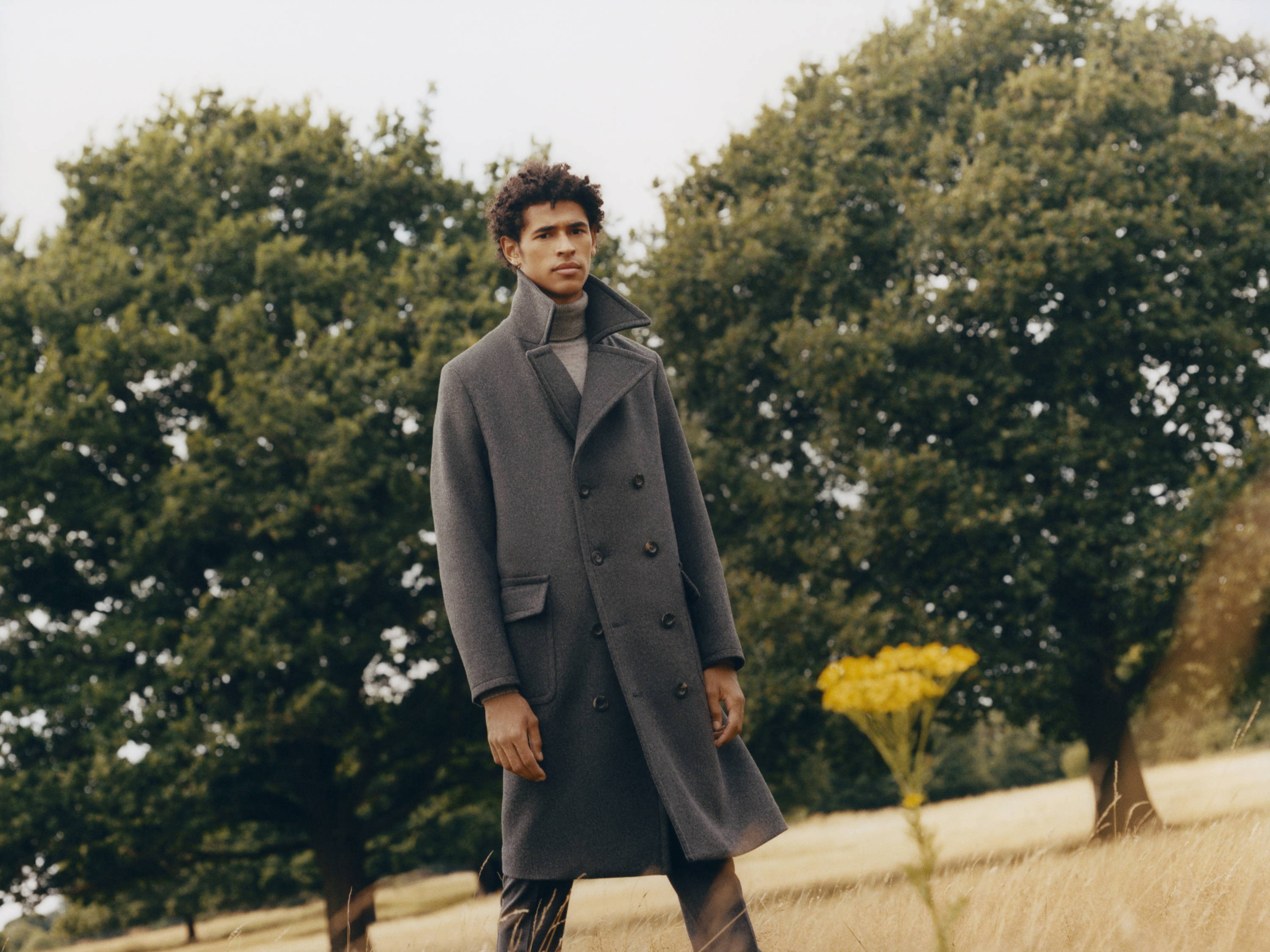Yarn from Donegal
This is the Donegal Overcoat. Yarn from Donegal, woven in Lancashire and manufactured in Manchester. As an idea, it had its origins in the observation that I wore my brown raglan coat more often than any other last winter. Despite the shortcomings of that piece (low collar, odd button positioning) it was a lovely material and easy to wear - just thrown over anything, whether smart or casual. As has happened with both previous collaborations (Bridge Coat and Trench Coat), these thoughts were the spur to start talking to Private White VC about making something even better.
I wanted to keep the cloth. Donegal tweed is so pleasing in the texture it creates, yet subtle. There’s slubbiness in there and colour variation when you look carefully, but it never feels as old-fashioned as a big windowpane.
Comfort Redefined
After a couple of samples, we figured out it wasn’t the collar itself but where it sat on the body. We needed to lift it up, so it encircled the neck and covered the shirt and tie when buttoned. This is practical, giving more protection from the wind, but also flattering, as it makes the wearer look taller as well as broader across the shoulders.
Walking the coast of Ireland (in fitting with the Donegal theme) put that to the test. Buttoning up just the top two buttons (also a style I like) showed how well the new collar design worked. There was no need for the throat latch, though we did test that as well. If you needed to, it was also possible to tighten the cuff of the coat against the cold. And fasten the vent closed at the back, with a hidden button.
Design Details
I carried across a couple of favourite design points from the Bridge Coat. One was the deep gold lining, which goes as well with grey Donegal and it did with the Bridge Coat’s navy. Distinctive, but not showy.
Another was cashmere-lined pockets. Frankly, I’ll never understand people that line pockets with bemberg or similar. It’s so cold. Cotton would be no more expensive, and a good deal warmer. But the ultimate is cashmere (and on both sides, front and back of the hand). It’s like putting on luxurious gloves every time you put your hands in there.
The buttons were also carried across: the matte, two-hole, dark-brown horn that is used on Savile Row tailoring and (for me) immediately separates this from normal ready-to-wear.
There are also small brown flecks in the Donegal cloth - some dark brown, some light - which go well with the buttons. It’s the key reason the coat works with things like jeans and brown suede I think, as well as tailoring. It softens the look.
I also reshaped the throat latch. It’s the only significant, asymmetric design point on a coat like this, and often ignored. Ours follows the line of the collar, with angled ends. And probably most importantly, the collar has a large crescent-shaped insert at the back, between it and the body of the coat.
You can wear the collar of this coat down, but I would always have it up - and it simply won’t stay up without that insert. It’s something bespoke overcoats often miss out, because they’re cut like a jacket and not designed to be popped up.
Yarn from Donegal
This is the Donegal Overcoat. Yarn from Donegal, woven in Lancashire and manufactured in Manchester. As an idea, it had its origins in the observation that I wore my brown raglan coat more often than any other last winter. Despite the shortcomings of that piece (low collar, odd button positioning) it was a lovely material and easy to wear - just thrown over anything, whether smart or casual. As has happened with both previous collaborations (Bridge Coat and Trench Coat), these thoughts were the spur to start talking to Private White VC about making something even better.
I wanted to keep the cloth. Donegal tweed is so pleasing in the texture it creates, yet subtle. There’s slubbiness in there and colour variation when you look carefully, but it never feels as old-fashioned as a big windowpane.
Comfort Redefined
After a couple of samples, we figured out it wasn’t the collar itself but where it sat on the body. We needed to lift it up, so it encircled the neck and covered the shirt and tie when buttoned. This is practical, giving more protection from the wind, but also flattering, as it makes the wearer look taller as well as broader across the shoulders.
Walking the coast of Ireland (in fitting with the Donegal theme) put that to the test. Buttoning up just the top two buttons (also a style I like) showed how well the new collar design worked. There was no need for the throat latch, though we did test that as well. If you needed to, it was also possible to tighten the cuff of the coat against the cold. And fasten the vent closed at the back, with a hidden button.
Design Details
I carried across a couple of favourite design points from the Bridge Coat. One was the deep gold lining, which goes as well with grey Donegal and it did with the Bridge Coat’s navy. Distinctive, but not showy.
Another was cashmere-lined pockets. Frankly, I’ll never understand people that line pockets with bemberg or similar. It’s so cold. Cotton would be no more expensive, and a good deal warmer. But the ultimate is cashmere (and on both sides, front and back of the hand). It’s like putting on luxurious gloves every time you put your hands in there.
The buttons were also carried across: the matte, two-hole, dark-brown horn that is used on Savile Row tailoring and (for me) immediately separates this from normal ready-to-wear.
There are also small brown flecks in the Donegal cloth - some dark brown, some light - which go well with the buttons. It’s the key reason the coat works with things like jeans and brown suede I think, as well as tailoring. It softens the look.
I also reshaped the throat latch. It’s the only significant, asymmetric design point on a coat like this, and often ignored. Ours follows the line of the collar, with angled ends. And probably most importantly, the collar has a large crescent-shaped insert at the back, between it and the body of the coat.
You can wear the collar of this coat down, but I would always have it up - and it simply won’t stay up without that insert. It’s something bespoke overcoats often miss out, because they’re cut like a jacket and not designed to be popped up.






Leave a comment
This site is protected by hCaptcha and the hCaptcha Privacy Policy and Terms of Service apply.